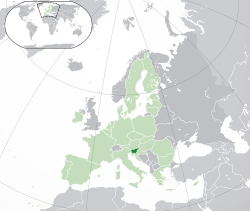Slovenia
Slovenia is a country in the southern region of Central Europe. The capital and largest city of Slovenia is Ljubljana. Its major language is Slovenian. Its current population is about 2.1 million. Slovenia's leading exports are manufactured goods and aluminium. It is a parliamentary republic[12] It is a member of the European Union and NATO.[13] The economy of Slovenia is small, open, and export-oriented.
Republic of Slovenia Republika Slovenija | |
|---|---|
| Anthem: Zdravljica [Note 1] | |
 Location of Slovenia (dark green) – on the European continent (green & dark grey) | |
| Capital and largest city | Ljubljana 46°03′00″N 14°30′00″E / 46.05000°N 14.50000°E |
| Official languages | Slovene (Slovenian) |
| Recognized languages | Italian Hungarian Croatian Serbian Romani English |
| Ethnic groups (2002[6]) | |
| Religion |
|
| Demonym(s) | |
| Government | Unitary parliamentary constitutional republic |
| Nataša Pirc Musar | |
| Robert Golob | |
| Legislature | Parliament |
| National Council | |
| National Assembly | |
| Establishment | |
• State of Slovenes, Croats and Serbs becomes independent | 29 October 1918 |
4 December 1918 | |
• Yugoslavia becomes a republic | 29 November 1943 |
• Independence from Yugoslavia | 25 June 1991 |
| Area | |
• Total | 20,273 km2 (7,827 sq mi) (153rd) |
• Water (%) | 0.7[7] |
| Population | |
• 2012 estimate | 2,055,496[8] (144th) |
• 2002 census | 1,964,036 |
• Density | 101[9]/km2 (261.6/sq mi) (106th) |
| GDP (PPP) | 2015 estimate |
• Total | $62.515 billion[10] |
• Per capita | $30,508[10] |
| GDP (nominal) | 2012 estimate |
• Total | $45.617 billion[10] |
• Per capita | $22,192[10] |
| Gini (2007) | 28.4 low |
| HDI (2013) | very high · 21st |
| Currency | Euro (€)b (EUR) |
| Time zone | UTC+1 (CET) |
• Summer (DST) | UTC+2 (CEST) |
| Date format | dd/mm/yyyy |
| Driving side | right |
| Calling code | +386 |
| ISO 3166 code | SI |
| Internet TLD | .sic |
| |
History
changeA very long time ago, Illyrian and Celtics tribes lived in Slovenia. In the 1st century BC, Slovenia was ruled by the Romans. In the sixth century AD, Slavs lived there. Slovenia was ruled by Austria from 1335 until 1918.
In 1918 it became a part of Yugoslavia. During World War II, Italy, Hungary and Germany took parts of the country but in 1945 it became part of Yugoslavia again.
In June 1991, Slovenia voted to become independent. Yugoslavia's army tried to stop this from happening but following a 10-day war, Slovenia became an independent country.
Currently, it is considered the most advanced country in what is called "Ex-Yugoslavia."[source?] It is also a member of the European Union.
Notable people
change- France Prešeren (1800-1849) is a very famous poet in his country.
- Melania Trump, Former First Lady of the United States
Related pages
changeReferences
change- ↑ As defined by the Act Regulating the Coat-of-Arms, Flag and Anthem of the Republic of Slovenia and the Flag of the Slovene Nation ("Zakon o grbu, zastavi in himni Republike Slovenije ter o slovenski narodni zastavi") from 1994 and published on the web page of the National Assembly of Slovenia.
- ↑ "PisRS". Pisrs.si. Retrieved 2 June 2012.
- ↑ "Archived copy". Archived from the original on 2008-01-23. Retrieved 2011-12-05.
{{cite web}}: CS1 maint: archived copy as title (link) - ↑ Božič, Dragan (3 November 2010). "Katero kitico č'mo kot himno zapet'" [Which Stanza Should We As the Anthem Sing?]. Delo.si (in Slovenian). ISSN 1854-6544. Archived from the original on 29 January 2011. Retrieved 14 February 2011.
- ↑ Škrinjar, Klara (3 September 2012). "Zdravljica v političnem in pravnem primežu" [Zdravljica in the Political and Legal Vice]. Delo.si (in Slovenian).
- ↑ "Census 2002: 7. Population by ethnic affiliation, Slovenia, Census 1953, 1961, 1971, 1981, 1991 and 2002". Statistical Office of the Republic of Slovenia. Archived from the original on 6 August 2011. Retrieved 2 February 2011.
- ↑ "Površina ozemlja in pokrovnost tal, določena planimetrično, 2005" [Surface area and land cover determined planimetrically, 2005] (in Slovenian and English). Statistical Office of the Republic of Slovenia. Archived from the original on 11 May 2011. Retrieved 2 February 2011.
- ↑ "Official Population Cloc". 26 September 2012. Archived from the original on 24 February 2015. Retrieved 5 December 2011.
- ↑ "Gostota naseljenosti, 1. 7" [Population density, 1 July] (in Slovenian and English). Statistical Office of the Republic of Slovenia. Archived from the original on 26 August 2013. Retrieved 2 February 2011.
- ↑ 10.0 10.1 10.2 10.3 "Slovenia". International Monetary Fund. Retrieved 17 April 2013.
- ↑ "Human Development Report 2010" (PDF). United Nations. 2010. Retrieved 2 November 2011.
- ↑ Reuvid, Jonathan (2005). Doing Business with Slovenia. GMB Publishing Ltd. p. 3. ISBN 978-1-905050-70-3.
- ↑ "Slovenia First 20 Years". Slovenia: South Australia Newsletter (58). Winter 2010–2011. ISSN 1448-8175. Retrieved 2012-11-25.
Notes
change- ↑ Melody by Stanko Premrl.[1][2][3][4] The question whether the entire Zdravljica or only its seventh stanza constitutes the Slovenian national anthem, remains unresolved. Whereas the Constitution of Slovenia determines the title of the poem, the act about the anthem specifically determines its seventh stanza. It has been argued that the act contradicts the constitution and that the question should be resolved by the Slovenian Constitutional Court.[5]
Other websites
change- Slovenia.si. Your gateway to information on Slovenia.
- Government of the Republic of Slovenia
- Slovenia Official Tourist Guide

